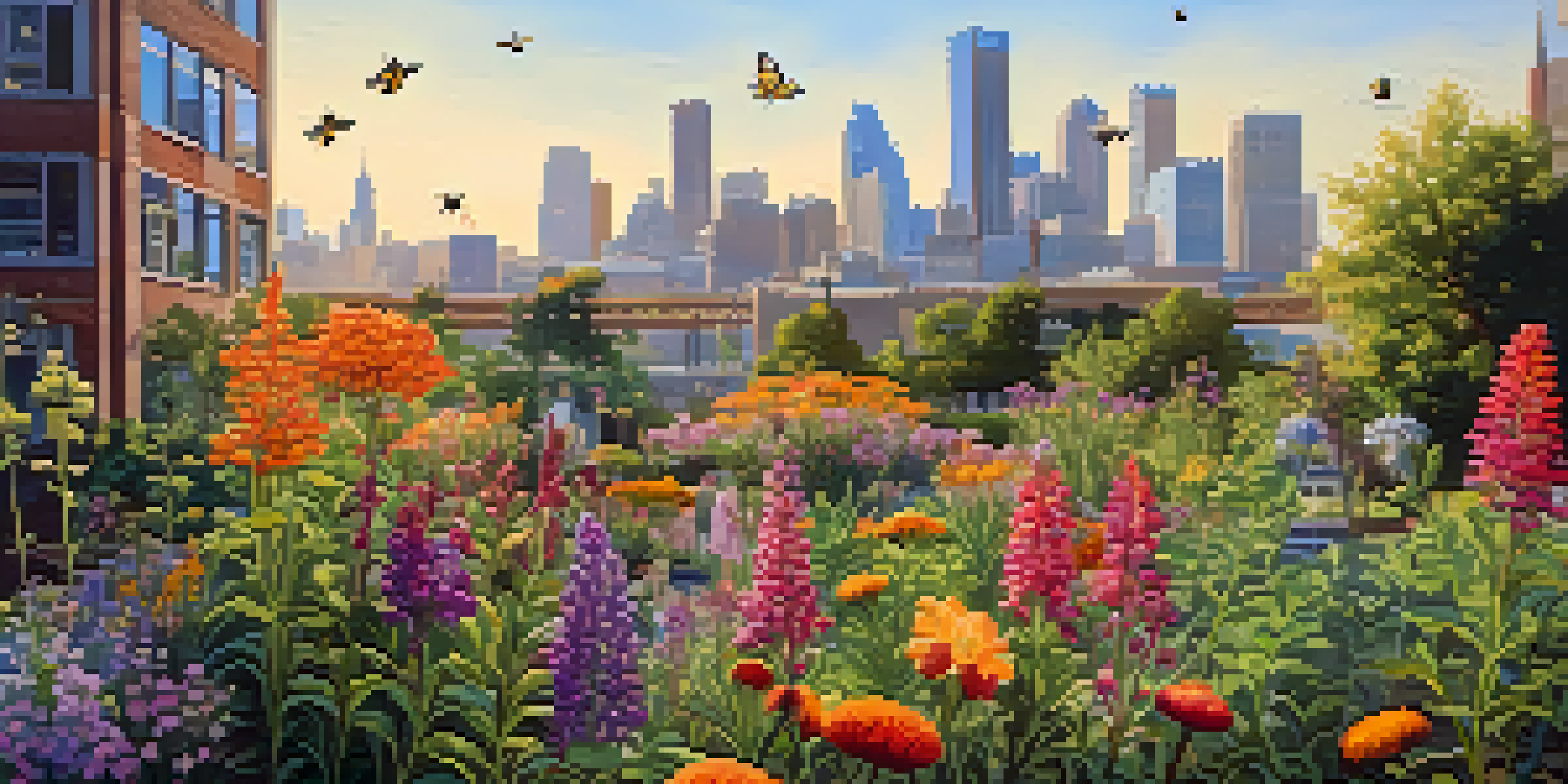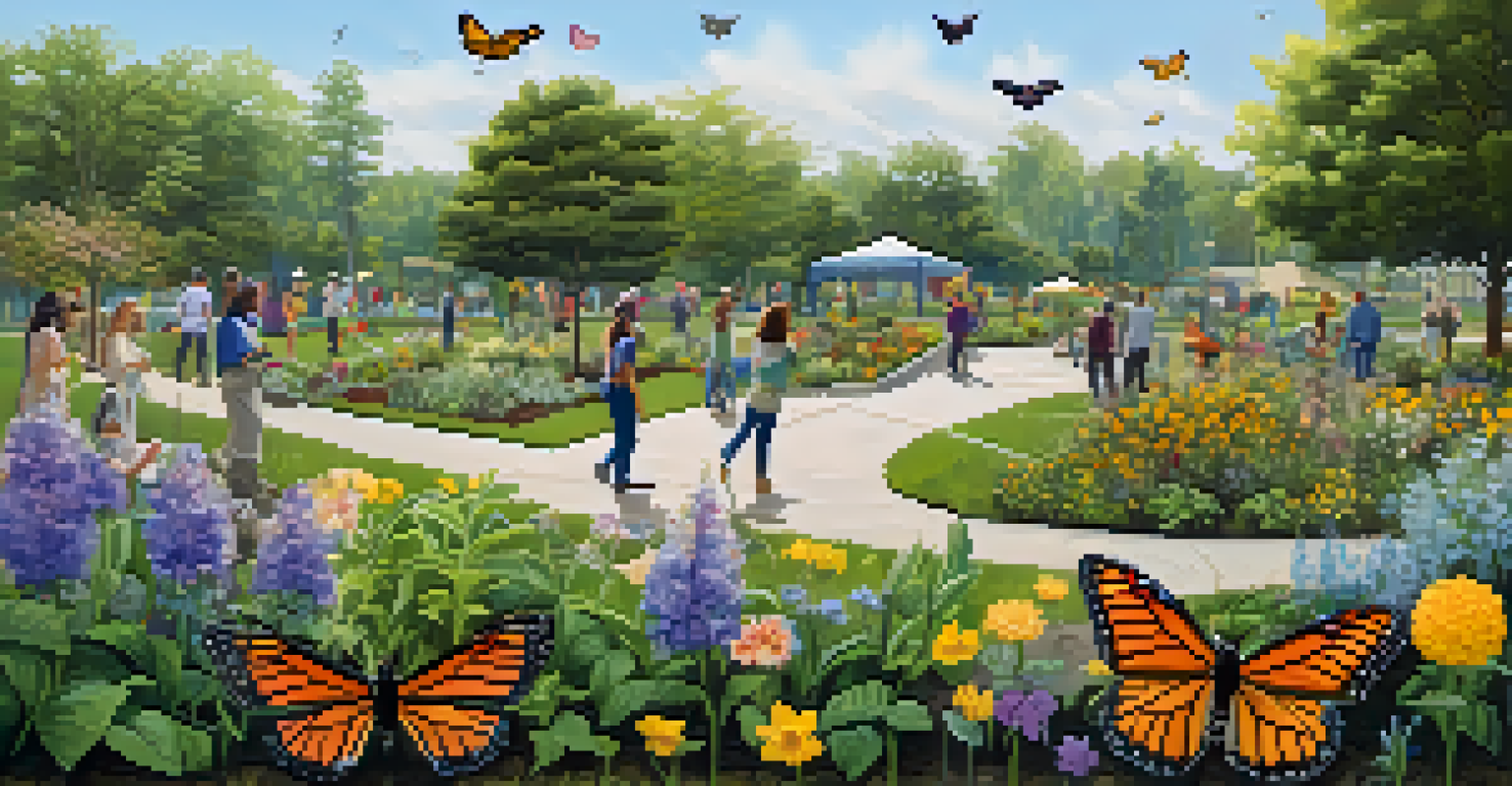The Connection Between Urban Plants and Pollinator Health

Understanding Pollinators and Their Importance
Pollinators, such as bees, butterflies, and birds, play a crucial role in our ecosystem. They are responsible for pollinating around 75% of the world's flowering plants, which includes many crops that sustain our food supply. Without these essential creatures, many plants would struggle to reproduce, leading to a decline in biodiversity.
The hum of bees is the voice of the garden. It is the sound of life and the promise of food.
Imagine a world without the vibrant colors of flowers or the sweet taste of fruits and vegetables. That's the reality we face if pollinator populations continue to dwindle. Urban areas, often seen as concrete jungles, can actually provide vital habitats for these species if designed thoughtfully.
Understanding the importance of pollinators helps us appreciate their role in maintaining ecological balance. By fostering environments that welcome these creatures, we can contribute to a healthier planet.
The Role of Urban Plants in Supporting Pollinators
Urban plants serve as essential food sources for pollinators. Flowers produce nectar and pollen, the primary food for many pollinators, and strategically planting diverse species can enhance the availability of these resources. This diversity creates a buffet of options, catering to various pollinator preferences.

Moreover, urban plants can extend the blooming season. By incorporating early and late-blooming species, we ensure that pollinators have access to food throughout the year. This is particularly important in cities, where natural habitats have been altered or lost due to development.
Pollinators are crucial for ecosystems
Pollinators like bees and butterflies are essential for the reproduction of 75% of flowering plants, directly impacting our food supply and biodiversity.
In essence, urban plants are not just decorative; they are lifelines for pollinators. By choosing the right plants, city dwellers can create a network of sustenance that contributes to pollinator health.
Creating Pollinator-Friendly Urban Spaces
Designing urban spaces with pollinators in mind is increasingly important. Community gardens, green roofs, and parks can become havens for these creatures, provided they are planted with native and flowering species. Native plants are particularly effective, as they are already adapted to the local environment and attract a variety of pollinators.
If we kill off the wild, then we will be killing off a part of our souls. The natural world is a part of our lives.
Encouraging local governments and organizations to implement pollinator-friendly practices can amplify these efforts. Initiatives like planting wildflower patches or reducing pesticide usage can significantly enhance pollinator habitats. Even small changes, such as adding a few flowering pots on a balcony, can make a difference.
Creating these spaces is not just beneficial for pollinators; it also enhances our urban environment. Green spaces improve air quality, reduce heat, and provide recreational areas for communities.
The Impact of Urbanization on Pollinator Populations
Urbanization poses significant challenges for pollinators, primarily through habitat loss and fragmentation. As cities expand, natural landscapes are replaced with concrete and asphalt, leaving pollinators with fewer places to thrive. This urban sprawl disrupts their migration routes and reduces their food sources.
Additionally, pollution and pesticide use in urban areas further threaten pollinator health. Chemicals can harm not just the target pests but also beneficial insects, leading to declining populations. Understanding the impact of our urban lifestyle is essential for mitigating these effects.
Urban plants support pollinator health
Strategically planting diverse, native species in urban areas creates vital habitats and food sources for pollinators throughout the year.
By acknowledging the consequences of urbanization, we can take proactive steps to protect pollinators. This awareness is the first step towards creating more sustainable urban environments.
The Importance of Native Plants in Urban Areas
Native plants are vital for supporting local pollinator populations. These plants have co-evolved with local insects, making them more attractive and beneficial to pollinators than non-native species. When we use native plants in urban landscaping, we provide the right food sources that local pollinators need to thrive.
Incorporating native plants into urban gardens and landscapes can also help restore ecological balance. This practice not only supports pollinators but also enhances biodiversity and provides habitats for other wildlife. A diverse ecosystem is healthier and more resilient.
Ultimately, choosing native plants is a win-win for both pollinators and urban residents. It fosters a deeper connection to nature while enhancing the beauty and functionality of urban spaces.
Community Engagement and Education on Pollinator Health
Community involvement is key to promoting pollinator health in urban areas. Educational programs that raise awareness about the importance of pollinators can inspire residents to take action. Workshops on creating pollinator gardens or planting native species can empower individuals to contribute positively to their environment.
Moreover, organizing community events, such as pollinator festivals or cleanup days, can bring people together. These activities create opportunities for hands-on learning and foster a sense of community pride and responsibility towards local ecosystems.
Community actions enhance biodiversity
Engaging communities through education and local initiatives can significantly improve pollinator health and urban biodiversity.
When communities come together to support pollinator health, the impact is multiplied. Collective efforts lead to more significant changes and a stronger commitment to preserving our urban environment.
Future Outlook: Enhancing Urban Biodiversity
Looking ahead, enhancing urban biodiversity is essential for the health of pollinators and our cities. As urban planners and policymakers recognize the importance of green spaces, we can expect to see more initiatives that integrate nature into urban design. This shift can lead to healthier ecosystems and improved quality of life for residents.
Innovative solutions, such as vertical gardens and urban farms, are emerging as ways to incorporate nature into densely populated areas. These initiatives not only provide food for pollinators but also offer fresh produce for communities, creating a symbiotic relationship between people and nature.

By prioritizing urban biodiversity, we can ensure that future generations inherit vibrant, healthy cities where both people and pollinators thrive.